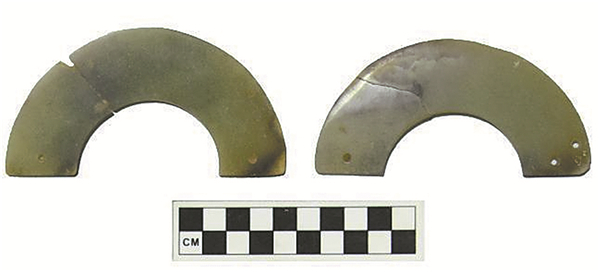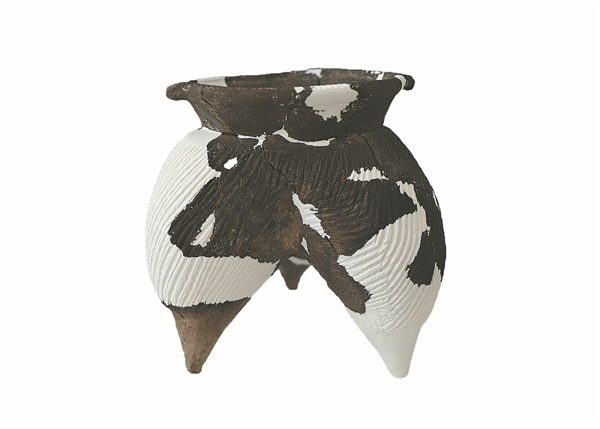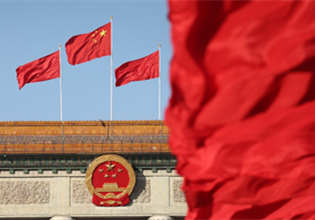Houchengzui stone ruins offer glimpse into prehistoric civilizations

Jade unearthed at the Houchengzui site in Hohhot, Inner Mongolia autonomous region provide a glimpse of people's lives about 4,000 years ago. [Photo provided to China Daily]
New discoveries from the ruins of a gigantic, prehistoric stone city in the north of China may unveil how an early civilization emerged along the Yellow River more than 4,000 years ago.
The three-year excavation of the Houchengzui site in Qingshuihe county of Hohhot, the capital of the Inner Mongolia autonomous region, revealed a city with complicated fortification systems, according to a release from a news conference held by the National Cultural Heritage Administration on Friday.
According to Sun Jinsong, director of the Cultural Relics and Archaeology Academy of Inner Mongolia, the surrounding moats as well as the outer defensive perimeters-known as barbicans-were the focus of recent research. The excavation also unveiled other defensive infrastructure including city gates, walls and bastions-structures that project outward from the walls to allow defensive fire in different directions.
"We even found two underground tunnels," Sun said. "One leads from the inner barbican to the outside of the city and the other is connected to the moat. Further study is needed to figure out what they were used for."
The Houchengzui site, which covers 1.38 square kilometers, was discovered in the 1980s, but major excavations did not begin until 2019.The site potentially holds great significance in decoding the region's early-stage civilizations.
The city existed from 4,500 to 4,200 years ago. This triggered archaeologists' strong curiosity, due to the city's similarity to the landmark, 4,000-year-old Shimao stone city ruins site in Shenmu, Shaanxi province.
Early-stage Chinese cities were usually built with earth and wood, leaving most of their heritage now invisible above the ground. Initially, the Shimao site, covering 4 sq km and made of stone, was mistakenly thought to be of the Ming Dynasty (1368-1644) until the past decade's discoveries showed its true age.
In 2020, the Shimao site, one of the largest prehistoric city ruins in China, was listed among the world's top 10 archaeological findings of the past decade by Archaeology Magazine, a publication of the Archaeological Institute of America.
Though Sun considered possible links between the Houchengzui and Shimao sites, he also pointed out the apparent differences between the two, particularly the format of the city gates.
The design of Houchengzui's city gates "resembles other earthen architectural ruins (from centuries later) in China's Central Plains region", Sun said. "That demonstrated communication among peoples across the regions."
Experts believe that studies of stone cities in the region may offer a bigger, fresher picture of early civilization along the Yellow River.

A piece of ottery unearthed at the Bicun site in Xingxian county, Shanxi province, provides a glimpse of people's lives about 4,000 years ago. [Photo provided to China Daily]
During the news conference on Friday, the Bicun site in Xingxian county, Shanxi province, dating back 4,200 to 3,800 years, was also highlighted. Zhang Guanghui, a researcher with the Shanxi Archaeology Academy who led the ongoing excavation, said this stone city site about 50 km from Shimao was probably a frontier border pass.
"Outposts were everywhere in the city, and its structure was rigidly planned," Zhang said. "It might have been a key strategic passageway connecting central and western China, which was pivotal for society then."
Unearthed jades and potteries provided a glimpse of different aspects of people's daily lives then.
Chen Xingcan, director of the Chinese Academy of Social Sciences' Institute of Archaeology, said, "The Houchengzui, Bicun and Shimao sites composed a cultural system that is crucial for the study of how a complicated society was formed in the first place.
"Many questions remain unanswered. If these sites were military fortifications, who did they defend against?" Chen said. "The work has just started, and there's a long way to go to more clearly figure out their connections."



 Print
Print Mail
Mail





